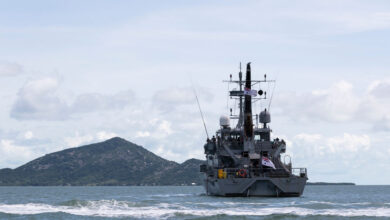Indian Navy boosting capabilities with six stealth submarines

Mandeep Singh
New Delhi’s decision to build six next-generation stealth submarines promises to answer the maritime threats posed by the People’s Republic of China in the Indian Ocean and to boost India’s defense industry. Analysts say the new submarines will also provide the Indian Navy with a critical component of the nation’s contribution to the Quadrilateral Security Dialogue (Quad), a grouping of like-minded Indo-Pacific democracies that includes Australia, Japan and the United States along with India.
“The Indian Navy needs greater patrolling ability in the IOR [Indian Ocean region] to project power as well as counter the Chinese naval might,” Dr. Yogesh Joshi, a research fellow with the National University of Singapore’s Institute of South Asian Studies, told FORUM. The submarines will bolster the Indian Navy’s “denial capabilities,” signaling to Beijing that the region is beyond its sphere of influence, particularly when teamed with the naval vessels of partner countries, Joshi said.
The six submarines, referred to collectively by New Delhi as Project-75 India (P-75I), will be diesel-electric powered but will use air-independent propulsion for enhanced underwater endurance, The Times of India newspaper reported. Each will be capable of carrying cruise missiles and heavyweight torpedoes. The total budget is about U.S. $7 billion. The leading Indian candidates to build the vessels are state-controlled Mazagon Dock Shipbuilders Ltd. and L&T Shipbuilding, a private firm. The selected builder is expected to collaborate with foreign partners on the vessels’ design and technology.
Air-independent propulsion also enables stealth maneuverability, Joshi said. Unlike nuclear-powered submarines, which emit sound due to constant cooling of their reactors, air-independent propulsion submarines can cruise the depths silently using advanced electric motors fueled by powerful batteries. This makes them ideal for coastal anti-submarine warfare (ASW) operations, where they pose a serious threat to nuclear-powered submarines that are less stealthy and less agile.
“From a cooperation perspective dealing with the submarines belonging to the Quad powers, anti-submarine warfare happens to be the critical component,” Joshi said. “This is also reflected in the past Quad exercise wherein ASW was the main theme.”
The ASW exercise, Sea Dragon 2021, involved the armed forces of all four Quad members plus Canada and was conducted at U.S. Andersen Air Force Base in Guam in mid-January 2021, according to U.S. Indo-Pacific Command.
P-75I is a “mega project” of Indian Prime Minister Narendra Modi’s “Make in India” initiative, established in 2014 to encourage firms to produce domestically and to promote manufacturing investments, according to The Times of India.
“In the submarine domain, India has developed so many capabilities since the 1970s, wherein it was aided by the French and the Germans in its conventional submarines and the Russians in the nuclear submarines,” Joshi said. “Having achieved the learning curve, the next step is the development of indigenous submarines.”
The Indian Navy’s sole nuclear-powered submarine, the INS Arihant, is armed with nuclear ballistic missiles, The Times of India reported. A second, the INS Arighat, is expected to be commissioned in 2021. In March 2021, India commissioned the INS Karanj, pictured, its third nonnuclear-powered submarine built under the predecessor project to P-75I. The Karanj is a Kalvari-class submarine built by Mazagon Dock Shipbuilders based on the French Scorpene design.
The first P-75I submarine should be ready for commission within a decade.
Mandeep Singh is a FORUM contributor reporting from New Delhi, India.
IMAGE CREDIT: THE ASSOCIATED PRESS




